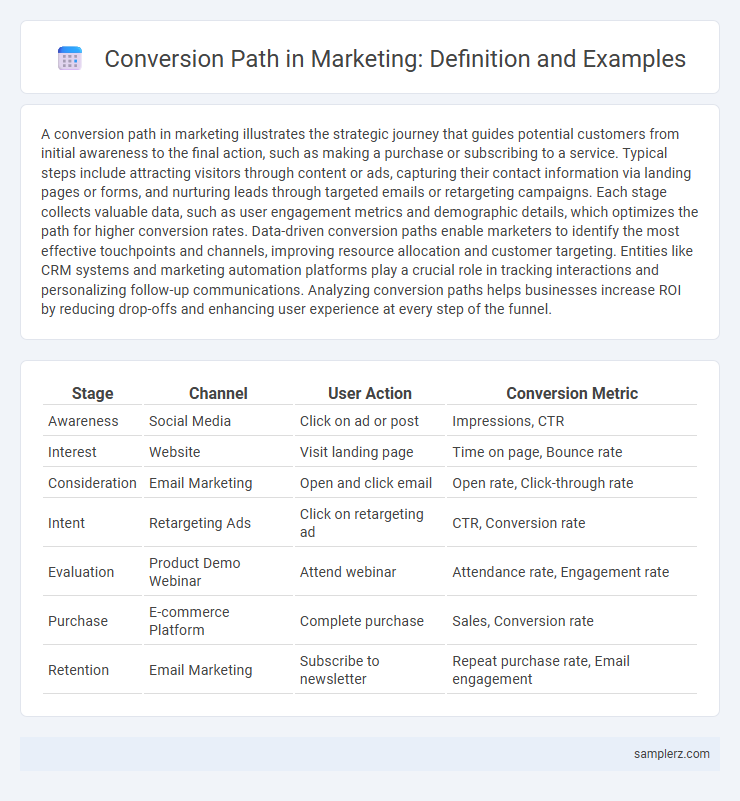A conversion path in marketing illustrates the strategic journey that guides potential customers from initial awareness to the final action, such as making a purchase or subscribing to a service. Typical steps include attracting visitors through content or ads, capturing their contact information via landing pages or forms, and nurturing leads through targeted emails or retargeting campaigns. Each stage collects valuable data, such as user engagement metrics and demographic details, which optimizes the path for higher conversion rates. Data-driven conversion paths enable marketers to identify the most effective touchpoints and channels, improving resource allocation and customer targeting. Entities like CRM systems and marketing automation platforms play a crucial role in tracking interactions and personalizing follow-up communications. Analyzing conversion paths helps businesses increase ROI by reducing drop-offs and enhancing user experience at every step of the funnel.
Table of Comparison
| Stage | Channel | User Action | Conversion Metric |
|---|---|---|---|
| Awareness | Social Media | Click on ad or post | Impressions, CTR |
| Interest | Website | Visit landing page | Time on page, Bounce rate |
| Consideration | Email Marketing | Open and click email | Open rate, Click-through rate |
| Intent | Retargeting Ads | Click on retargeting ad | CTR, Conversion rate |
| Evaluation | Product Demo Webinar | Attend webinar | Attendance rate, Engagement rate |
| Purchase | E-commerce Platform | Complete purchase | Sales, Conversion rate |
| Retention | Email Marketing | Subscribe to newsletter | Repeat purchase rate, Email engagement |
Understanding the Conversion Path in Marketing
A typical conversion path in marketing involves stages such as awareness, interest, consideration, and action, guiding prospects from initial contact to completing a desired goal like a purchase or sign-up. Key touchpoints include targeted content, landing pages, call-to-actions, and lead capture forms, each optimized to nurture leads and drive conversions. Analyzing user behavior through tools like Google Analytics helps marketers refine each step of the conversion path, increasing overall campaign effectiveness and ROI.
Key Stages of a Typical Conversion Path
A typical conversion path in marketing involves key stages such as awareness, consideration, and decision. During awareness, potential customers encounter brand messaging through channels like social media or search ads, leading to interest. The consideration stage includes engaging content or retargeting efforts, while the decision phase involves calls-to-action, landing pages, and optimized checkout processes to drive final conversions.
Top-of-Funnel: Attracting Initial Interest
Top-of-Funnel conversion paths in marketing often begin with targeted content such as blog posts, social media campaigns, and SEO-driven landing pages designed to attract initial interest. Effective strategies include leveraging keyword-rich articles and engaging multimedia to capture organic traffic and generate awareness among potential leads. These efforts build a foundation for nurturing prospects through subsequent stages of the marketing funnel.
Middle-of-Funnel: Nurturing Leads with Valuable Content
Middle-of-Funnel (MOFU) conversion paths focus on nurturing leads by delivering valuable content such as in-depth ebooks, case studies, and targeted webinars that address specific pain points. Personalized email campaigns and retargeting ads help maintain engagement and guide leads toward considering your solution. Effective MOFU strategies increase lead qualification rates and drive higher conversion potential for sales teams.
Bottom-of-Funnel: Encouraging the Final Conversion
Bottom-of-funnel conversion paths typically include targeted email campaigns offering exclusive discounts, personalized product recommendations based on user behavior, and optimized landing pages designed for seamless checkout experiences. These strategies leverage retargeting ads and customer testimonials to build trust and reduce hesitation before purchase. Data-driven approaches monitor engagement metrics to refine calls-to-action, maximizing conversion rates and driving revenue growth.
Example 1: Conversion Path for an E-Commerce Store
A typical conversion path for an e-commerce store begins with targeted social media ads driving traffic to a product landing page optimized for user experience and fast loading times. Visitors then enter their email to receive a discount code, triggering a personalized email sequence that highlights product benefits and customer reviews. The final step involves retargeting ads reminding users of their abandoned carts, boosting the likelihood of completed purchases and increased sales revenue.
Example 2: Conversion Path for a B2B SaaS Business
A typical conversion path for a B2B SaaS business begins with targeted content marketing, such as informative blog posts or whitepapers addressing pain points faced by professionals in the industry. This initial engagement is followed by lead capture through gated assets like webinars or demo sign-ups, collecting vital contact information. The sales team then nurtures these leads via personalized email sequences and free trials, ultimately converting prospects into paying subscribers through tailored product demos and consultations.
Optimizing Touchpoints Along the Conversion Path
Optimizing touchpoints along the conversion path enhances customer engagement and improves lead conversion rates by refining each interaction from awareness to purchase. Key touchpoints include targeted content delivery, personalized email campaigns, and retargeting ads that address specific customer needs and behaviors. Leveraging analytics to monitor user behavior at each stage allows marketers to adjust strategies, increase conversion efficiency, and maximize return on investment.
Common Mistakes in Marketing Conversion Paths
Common mistakes in marketing conversion paths include neglecting mobile optimization, which leads to high bounce rates and lost potential customers. Ignoring personalized content reduces engagement, as visitors fail to see relevant offers tailored to their needs. Overcomplicating checkout processes causes unnecessary friction, resulting in abandoned carts and lower conversion rates.
Measuring the Success of Your Conversion Path
Tracking key metrics such as click-through rates, bounce rates, and final conversion rates provides clear insights into the effectiveness of each stage within a conversion path. Using tools like Google Analytics and CRM platforms enables marketers to measure user interactions, identify drop-off points, and optimize touchpoints to boost overall ROI. Consistent analysis of these performance indicators helps fine-tune campaigns, ensuring higher lead quality and increased customer acquisition.

example of conversion path in marketing Infographic
 samplerz.com
samplerz.com